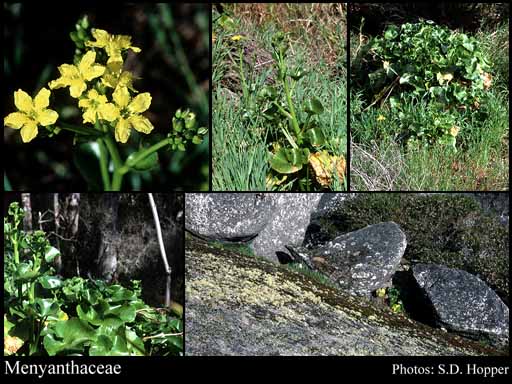- Reference
- Anal.Fam.Pl. p20, 25 (1829)
- Name Status
- Current







Scientific Description
Common name. Buckbean Family.
Habit and leaf form. Herbs. Plants with a basal concentration of leaves. Hydrophytic, or helophytic; when hydrophytic, rooted. Leaves alternate; spiral; petiolate; sheathing; simple, or compound; peltate (sometimes), or not peltate; when compound, ternate. Leaf blades when simple, entire; pinnately veined, or palmately veined; cross-venulate. Leaves without stipules; without a persistent basal meristem. Leaf anatomy. Hydathodes present. Stem anatomy. Nodes tri-lacunar, or penta-lacunar. Secondary thickening absent, or developing from a conventional cambial ring.
Reproductive type, pollination. Fertile flowers hermaphrodite. Unisexual flowers absent. Plants hermaphrodite. Plants commonly heterostylous. Entomophilous.
Inflorescence and flower features. Flowers solitary, or aggregated in ‘inflorescences’; in cymes, in heads, in fascicles, and in panicles. The terminal inflorescence unit cymose, or racemose. Inflorescences scapiflorous, or not scapiflorous; fascicles, many flowered cymes, panicles or involucrate heads; with involucral bracts, or without involucral bracts. Flowers small to medium-sized; regular; usually 5 merous; cyclic; tetracyclic. Free hypanthium absent. Hypogynous disk present; intrastaminal. Perianth with distinct calyx and corolla; 10; 2 -whorled; isomerous. Calyx 5; 1 -whorled; polysepalous, or gamosepalous (sometimes connate); regular. Corolla 5; 1 -whorled; appendiculate (with interstaminal scales), or not appendiculate; gamopetalous (with a tube); valvate (or induplicate-valvate); regular. Corolla members often fringed (or crested). Androecium 5, or 10 (if the scales which sometimes alternate with the stamens are interpreted as staminodes). Androecial members adnate (to the tube); free of one another. Androecium exclusively of fertile stamens, or including staminodes (depending on interpretation of the scales). Staminodes if regarded as such, 5. Stamens 5; isomerous with the perianth; oppositisepalous (the filaments alternating with the C lobes). Anthers sagittate; versatile; dehiscing via longitudinal slits; introrse; tetrasporangiate. Gynoecium 2 carpelled. The pistil 1 celled. Carpels reduced in number relative to the perianth. Gynoecium syncarpous; synstylovarious; superior, or partly inferior. Ovary unilocular; 1 locular. Gynoecium median; stylate. Styles 1 (shortly bifid); apical. Stigmas 2; wet type; papillate; Group III type. Placentation parietal (two placentas). Ovules in the single cavity 10–100 (‘many’); horizontal; anatropous.
Fruit and seed features. Fruit fleshy, or non-fleshy; dehiscent, or indehiscent; a capsule, or a berry. Capsules septicidal, or loculicidal, or valvular. Fruit 4–100 seeded (‘few to many’). Seeds endospermic. Endosperm oily. Seeds winged, or wingless. Cotyledons 2. Embryo straight.
Geography, cytology, number of species. World distribution: cosmopolitan. X = 9, 17. 40 species.
Keys
Western Australian Genera and Families of Flowering Plants — an interactive key
T.D. Macfarlane, L. Watson, N.G. Marchant